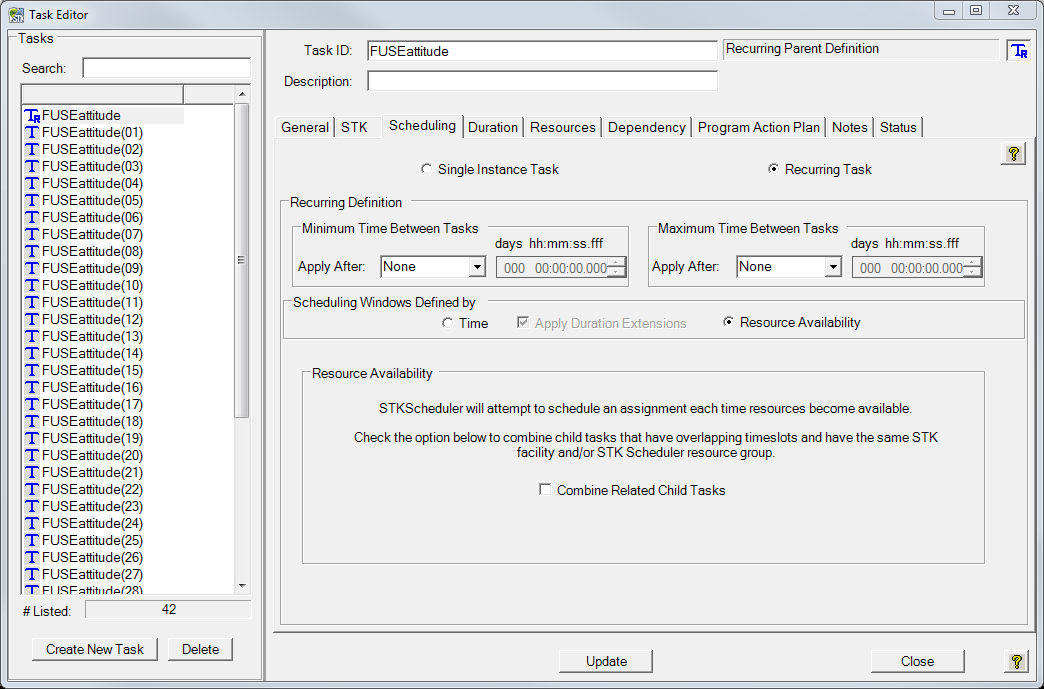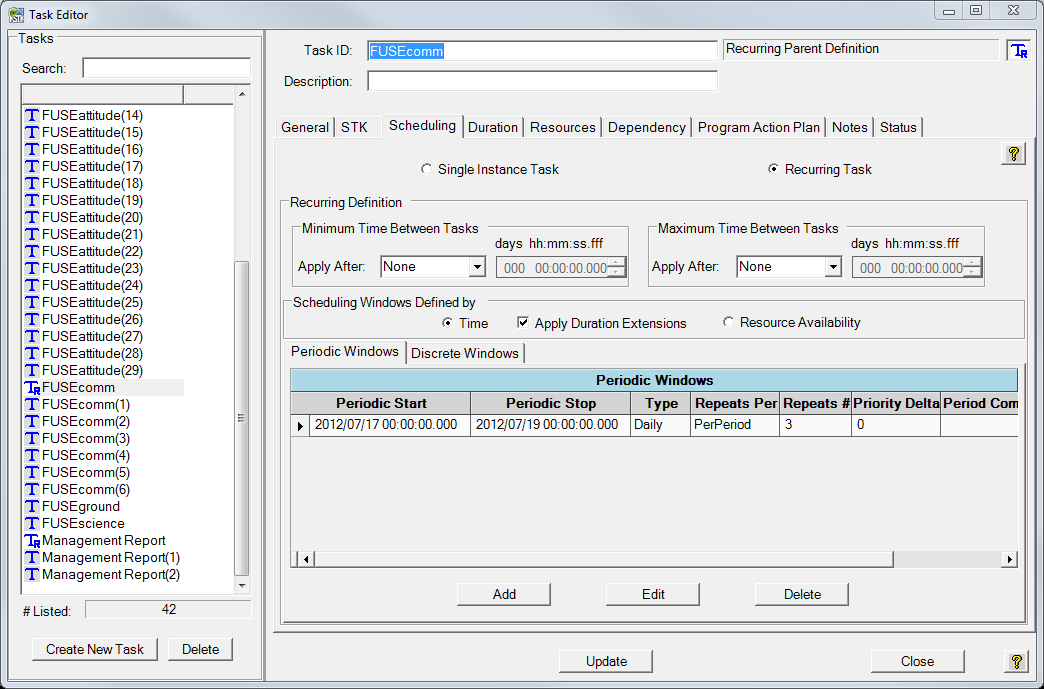Scheduling Recurring Tasks
Recurring Task Option Button
The recurring task option button allows you to define the current task as a Recurring Task Parent Definition (see Task Types). Clicking the Recurring Task Option Button will cause the Recurring Definition Frame to appear.
To display the Scheduling Tab, select Task -> Task Editor from the Menu Bar, then click on the Scheduling Tab. The window will change depending on whether you select the "Time" or "Resource Availability" radio button option. Both views are displayed below.
Recurring Task Scheduling Tab with "Resource Availability" option checked

Recurring Task Scheduling Tab with "Time" option checked

Minimum and Maximum Time Between Definitions
You may apply minimum and/or maximum time between constraints for recurring tasks, if desired, by checking the applicable Apply button(s) and defining the time interval and reference time (task start or stop time) for each as necessary. If a minimum time between constraint is applied, the algorithms will ensure that each recurring task instance start time is no closer than the defined minimum time interval after the previous instance assignment reference time (start or stop time). If a maximum time between constraint is applied then the algorithms will ensure that each recurring task instance start time is assigned no later than the defined time interval after the previous instance assignment reference.
Maximum time between constraints may only be applied to recurring tasks based on time (not resource availability) that include only a single instance per repeat period (e.g. daily). Maximum time between constraints may not be applied to recurring tasks with multiple repeats per period due to the non-deterministic assignment order time sequence. You should take care not to define maximum time between constraints for recurring tasks where the period duration is longer than the interval between period boundaries (e.g. daily tasks with a window duration of more than one day).
Scheduling Windows Defined by Frame
When defining recurring tasks, Astro Scheduler Engine will create multiple task instances. Instances will be assigned based on a consecutive series of time windows. The time windows may be defined either by user-defined time windows or by the availability of the resources required by the task.
Time Option Button
The time option button causes the additional restrictive windows frame to appear. This frame allows you to define times during which the Task Instances must occur. Times may be defined as one or more periodic windows that occur at regular intervals and/or by one or more discrete windows that occur only once.
Apply Duration Extensions Checkbox
The following will occur if the value is checked (default is checked).
The apply duration extensions checkbox will extend the recurring children tasks timeslots. The amount of duration the timeslots will extend will be dependent on the task's duration type and value.
- A fixed duration type will extend the timeslot by the duration value minus one time unit (millisecond).
- A maximized duration type with a maximum value will extend the timeslot by the maximum duration values minus one time unit (millisecond).
- An unlimited maximize duration type will extend the timeslot to the end of the schedule.
In addition, a start no later than constrain will be applied to the recurring children's task assignments. The value of this constraint will be the periodic boundary end time minus one time unit (millisecond). The purpose of extending the timeslot is to allow a task assignment to cross the periodic boundary, while ensuring that the assignment starts within the periodic boundary. The following are 2 examples:
- A periodic definition of daily is created for a recurring parent for a 2 day schedule. The parent duration type is fixed to 10 minutes. The first child task has a timeslot that starts at midnight on day 1, and extends to 10 minutes past midnight of day 2 (minus 1 millisecond, or 9 minutes 59 seconds and 999 milliseconds past midnight).
- You want to create a recurring set of tasks that occur every orbit. He creates a STK report definition with a report that uses the ascending node for a satellite. The parent duration type is a maximize unlimited task. The first child task has a timeslot that starts at the first ascending node after the schedule start, and ends at schedule stop.
Both examples above allow assignments to extend beyond the periodic boundary, as long as they start prior to the periodic stop time.
If turned off, the recurring children task's timeslots will be adjusted. This will force all the children's assignments to start and end within a periodic boundary (not allow then to straddle the periodic start time).
Resource Availability Option Button
The resource availability option button causes the additional restrictive windows frame to disappear. With this option button selected, Astro Scheduler Engine will internally define a series of windows of time each beginning when all of the required resource for a particular possibility are not available to be tasked and have access to each other (if the resources are STK objects) and ending when either the availability or access of at least one of the required resources is lost. Task Instances will be created for each of these windows of time. In Astro Scheduler Engine terms this means that a separate task will be created for each computed Timeslot.
Combine Related Child Tasks Checkbox
The Combine Related Child Task checkbox will combine the task children created from this parent recurring by resource task based on the following conditions.
- Child tasks have overlapping timeslots.
- Child tasks use resources that belong to the same Astro Scheduler resource group AND/OR child tasks use resources that are associated with the same facility in their Astro Scheduler Engine definition.
AND
The purpose of this option is to combine what would be multiple near-simultaneous tasking opportunities from a cluster of ground stations, antennas, or other resources as a single pass in Astro Scheduler Engine into a single Astro Scheduler task with multiple near-simultaneous options, consistent with normal operations concept for ground contact scheduling. The scheduling results will be the same with or without this option selected, but there may be some confusion by operators if they see several unscheduled tasks in Astro Scheduler Engine (which are really just un-assigned options for what would normally be considered a single tasking opportunity).
Periodic Windows Tab
The periodic windows tab allows you to define regularly occurring windows of time within which the Task Instance must occur.
Add Button
Clicking the Add button opens the Periodic Window Definition Form. This form allows you to create windows of time to restrict when a task may be scheduled.
When opening the Periodic Window Definition form from this location, you will encounter context dependent controls on that form. Click here for more information on these controls.
Edit Button
Clicking the Edit button opens the Periodic Window Definition Form populated with information from the selected scheduling window allowing you to change its attributes.
When opening the Periodic Window Definition Form from this location, you will encounter context dependent controls on that form. Click here for more information on these controls.
Delete Button
Clicking the Delete button allows you to permanently remove a selected scheduling window.
Discrete Windows Tab
The discrete windows tab allows you to define individual windows of time within which the Task Instances must occur.
Add Button
Clicking the Add button opens the Discrete Window Definition Form. This form allows you to create windows of time to restrict when a task may be scheduled.
Edit Button
Clicking the Edit Button opens the Discrete Window Definition Form populated with information from the selected scheduling window allowing you to change its attributes.
Delete Button
Clicking the Delete button allows you to permanently remove a selected scheduling window.
STK Import Button
Clicking the STK Import button opens the STK Report Definition Form. This form allows you to define and modify STK time-based reports that will be used for defining discrete windows to be used for defining the task's scheduling times.
